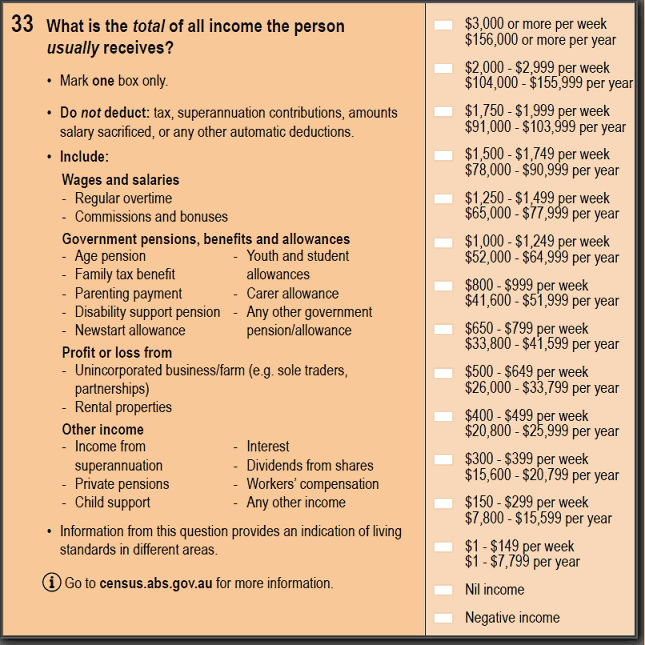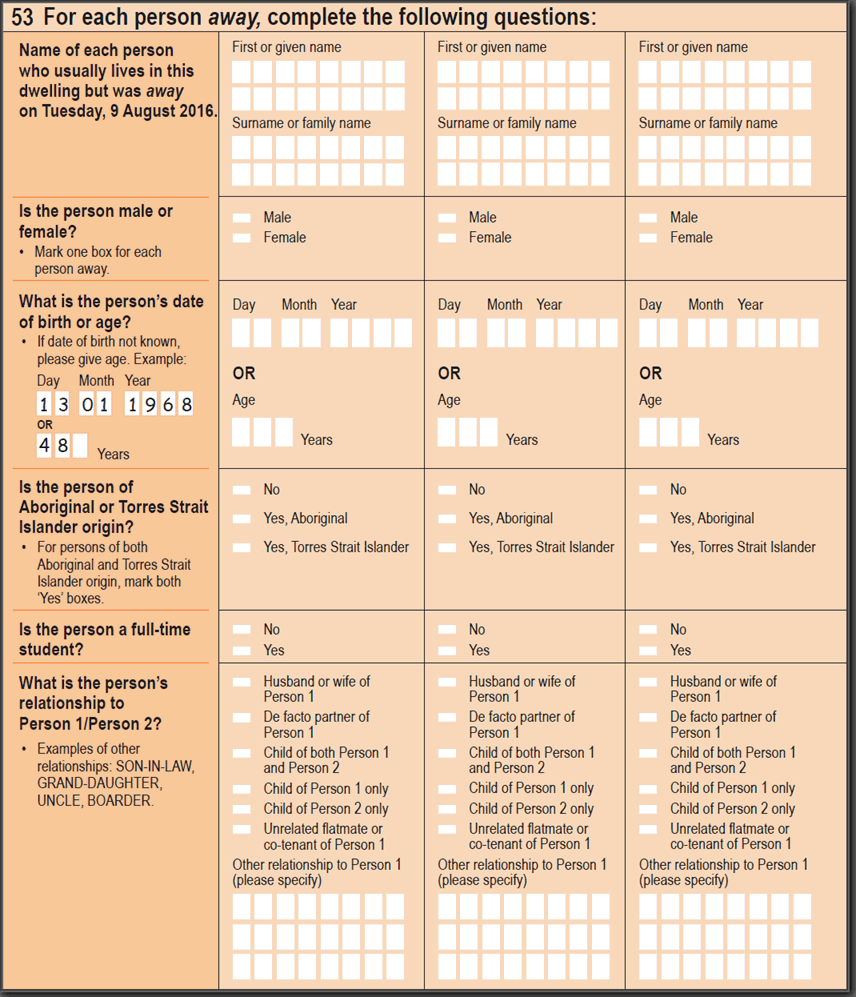Total Family Income (Weekly) (FINF)
This variable records the sum of the Total Personal Income (weekly) of each family member aged 15 years and over present in the household on Census night. Total Personal Income (weekly) is applicable to all families where one or more members is aged 15 and over. Family income is not applicable to non-family households such as group households or lone person households; or to people in non-private dwellings.
How this variable is created
Data for this variable is derived from the Relationship in Household, Income and Persons Temporarily Absent questions on the Census Household Form. Images of these questions are provided below.
Total Family Income (Weekly) is calculated by summing the personal incomes reported by all family members aged 15 years and over. As personal income is collected in ranges, median values are assigned to each range using data from the Survey of Income and Housing.
If any person aged 15 years and over is temporarily absent, or does not state their income, then the Total Family Income (weekly) is not derived for that family.
The categories of Total Family Income (Weekly) include: 'Partial income stated' and 'All incomes not stated'. 'Partial income stated' is used when some family members (aged 15 years and over) are temporarily absent or have not stated their income. 'All incomes not stated' is used when no family member present (aged 15 years and over) has stated their income.
Variable history
This variable was first introduced in 1976 as Family Income (Annual) (FINP), though the name and mnemonics used, and methods used to calculate family income, have changed several times over the years. For the 2016 Census, categories for family income in dollar ranges have been revised.
Non-response rate
Item non-response rates are a measure of how many people did not respond to a particular question as a proportion of the total number of people the question was applicable to. In this instance the response is left as not stated.
The majority of item non-response is attributable to the people who did not respond to the Census at all. The second and smaller contributor to item non-response is when people return a Census form but may not answer a particular question(s). For more information, refer to Understanding Census data quality
The non-response rate for this variable where all persons in the family did not state an income was 1.5%, while families with partial income stated was 9.5% of families. Families where all or at least one member aged 15 years and over did not state an income are set to 'All incomes not stated' and 'Partial income stated' respectively. Families where at least one member aged 15 years and over was temporarily absent on Census Night are also set to 'Partial income stated'.
Data usage notes
If there is a need to recalculate this variable under different circumstances users can use the derived variable Family Income Derivation Indicator (FIDF) in conjunction with Total Personal Income (weekly) (INCP) to create a new family income variable.
Total Family Income (Weekly) should be used carefully when comparing to other family data from within the ABS and for external organisations or agencies. The definition of a family can differ between different statistical collections and may not match Census definitions.
Further information
A definition for Total Family Income (Weekly) is available in the 2016 Census Dictionary.
For information on the Relationship in Household question and data item, see the data quality statement for Relationship in Household.
For information on family type and family composition, see the data quality statement for Family Composition.
Household form question image
Data for this variable is derived from the following questions on the Census Household Form:
- Question 5, which is used to determine person's relationship to 'Person 1'/'Person 2',
- Question 33 which is used to determine Income, and
- Question 53, which is used to determine Persons Temporarily absent.
Questions 5, 33 and 53 as they appear on the 2016 Census Household Paper Form:



A text only version of the online Census Household form is available from the Downloads tab.
 Print Page
Print Page
 Print All
Print All